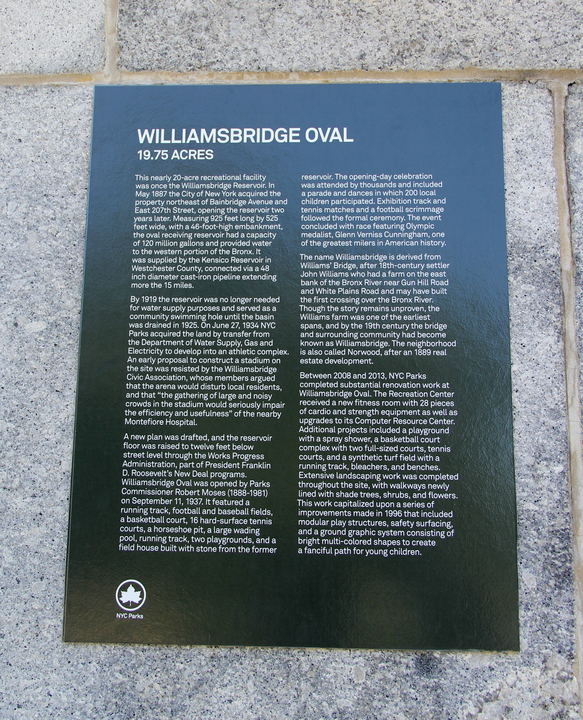
In fairness it should be pointed out that the WPA did more than just raise level of the reservoir bottom; it funded, designed, and built the park and the Recreation Center from top to bottom, employing about 100 people over three years, spending 1.5M 1930s dollars (about $27 million today). They even quarried and cut the granite on site that they used to construct the Recreation Center. The project was proposed and supervised by the NYC Parks Department, but it was paid for and carried out by the WPA, including architects and engineers who worked at Parks but were paid by the New Deal. This is the normal way the WPA worked all over the country: state and local government agencies proposed the projects, and the WPA paid for them and supplied the labor at all levels.WILLIAMSBRIDGE OVAL
19.75 ACRESThis nearly 20-acre recreational facility was once the Williamsbridge Reservoir. In May 1887, the City of New York acquired the property northeast of Bainbridge Avenue and East 207th Street, opening the reservoir two years later. Measuring 925 feet long by 525 feet wide, with a 46-foot-high embankment, the oval receiving reservoir had a capacity of 120 million gallons and provided water to the western portion of the Bronx. It was supplied by the Kensico Reservoir in Westchester County, connected via a 48-inch diameter cast-iron pipeline extending more the 15 miles.By 1919, the reservoir was no longer needed for water supply purposes and served as a community swimming hole until the basin was drained in 1925. On June 27, 1934, NYC Parks acquired the land by transfer from the Department of Water Supply, Gas and Electricity to develop into an athletic complex. An early proposal to construct a stadium on the site was resisted by the Williamsbridge Civic Association whose members argued that the arena would disturb local residents, and that “the gathering of large and noisy crowds in the stadium would seriously impair the efficiency and usefulness” of the nearby Montefiore Hospital.
A new plan was drafted, and the reservoir floor was raised to twelve feet below street level by Works Progress Administration workers. Williamsbridge Oval was opened by Parks Commissioner Robert Moses (1888-1981) on September 11, 1937. It featured a running track, football and baseball fields, a basketball court, 16 hard-surface tennis courts, a horseshoe pit, a large wading pool, running track, two playgrounds, and a field house built with stone from the former reservoir. The opening-day celebration was attended by thousands and included a parade and dances in which 200 local children participated. Exhibition track and tennis matches and a football scrimmage followed the formal ceremony. The event concluded with race featuring Olympic medalist, Glenn Verniss Cunningham, one of the greatest milers in American history.
The name Williamsbridge is derived from Williams' Bridge, after 18th-century settler John Williams who had a farm on the east bank of the Bronx River near Gun Hill Road and White Plains Road and may have built the first crossing over the Bronx River. Though the story remains unproven, the Williams farm was one of the earliest spans, and by the 19th century the bridge and surrounding community had become known as Williamsbridge. The neighborhood is also called Norwood, after an 1889 real estate development.
Between 2008 and 2013, NYC Parks completed substantial renovation work at Williamsbridge Oval. The Recreation Center received a new fitness room with 28 pieces of cardio and strength equipment as well as upgrades to its Computer Resource Center. Additional projects included a playground with a spray shower, a basketball court complex with two full-sized courts, tennis courts, and a synthetic turf field with a running track, bleachers, and benches. Extensive landscaping work was completed throughout the site, with walkways newly lined with shade trees, shrubs, and flowers. This work capitalized upon a series of improvements made in 1996 that included modular play structures, safety surfacing, and a ground graphic system consisting of bright multi-colored shapes to create a fanciful path for young children.